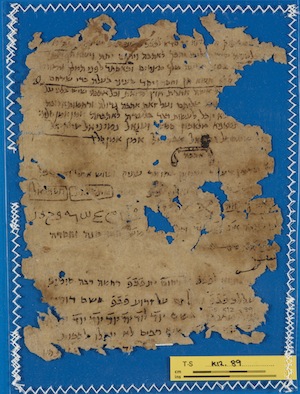T-S K12.89: ‘Like Esther in front of Ahasuerus’
Ortal-Paz Saar, Tel Aviv University
A British Academy Visiting Fellowship allowed me to spend the months of May and June 2009 at the Genizah Research Unit in Cambridge, and catalogue manuscripts pertaining to the fields of magic and astrology. Of these fragments the ones related to love and favour bear a special interest to me, as they constituted the topic of my doctoral dissertation, written under the supervision of Professor Gideon Bohak. The fragment presented below, T-S K12.89, belongs to this class. It is a paper leaf written in Hebrew and Aramaic, containing several sets of instructions designed to achieve love through magical means. The instructions are generic and use the expression ‘N son/daughter of N’ ('פלוני בן/בת פלונית, פ'ב'פ) to denote the names of actual persons. These names were to be filled in by the magical practitioner when performing the ritual.
The first among these magical recipes is intended to ensure a great affection between a wife and her husband, erasing any animosity that might exist between them. The fragment preserves some beautiful biblical analogies:
[...] May every hatred that there is in his heart turn to love, and may he love her and have grace and favour [...]
[like J]oseph in front of Pharaoh the King of Egypt, and like Esther in front of King Ahasuerus
[...] N daughter of N will have grace and favour and glory in the eyes of her husband so that he will love
[her]
[ ] כל סטנא שיש [ב]לבו יהפך לאהבה וירחם יתה וישא חן וחסד
[ כיו]סף בפני פרעה מלך מצרים וכאסתר לפני המלך אחשורוש
[ ] פ'ב'פ' תשא חן וחסד ויקר בעיני בעלה כדי שירחם
The wife is likened to two biblical characters, one male and one female, who found favour with monarchs. The intention of the magical incantation is clear: to bestow upon the wife a grace similar to that of Joseph and Esther, making her lovable in the eyes of her spouse.
Biblical analogies are a notable feature of Jewish love magic in the Genizah. Characters such as Noah, Joseph, Esther and Ezra appear in spells for finding favor with a specific person or with an entire social group, as well as in spells designed to obtain love. The Patriarchs and Matriarchs also play a part in Genizah magical incantations, exemplifying strong and unyielding affection, for instance in the erotic amulet T-S AS 142.39: ‘May the love between X and Y be like the love between Abraham and Sarah, and like the love between Isaac and Rebecca, and like the love between Jacob and Rachel (…)’. It would appear that biblical analogies served two purposes, the first and obvious being to harness the power of biblical characters’ renown for specific deeds or qualities for the magician’s use. The second is one we may only surmise: to improve the aesthetic and poetic quality of the magical incantations, perhaps believing this would also enhance their efficiency.
The second recipe preserved in our fragment bears the title ‘Love’, emphasised by the drawing of a canopy over the word. It instructs the practitioner to take ‘seven leaves of laurel and grind them in old wine’, after which he is to write several magical names, perhaps using the mixture prepared earlier, or else, to write the names on the laurel leaves. The recipe ends with another biblical quotation, this time from the Song of Songs 8:7:
מים רבים לא יוכלו לכבות
[את האהבה ]
Many waters cannot quench
[love ]
The Song of Songs holds a special place in Jewish love incantations, for understandable reasons. Yet what is of special interest is that the fragment might contain an additional reference to a verse from this book. The magical recipe gives an instruction to attach the amulet prepared using the laurel leaves to the arm of the person who commissioned the spell (or perhaps, the arm of the person who is the target of the spell; the phrasing is unclear due to the fragmentary nature of the text). The beloved in the Song of Songs 8:6 beautifully requests: ‘Place me (…) as a seal upon your arm’. The word ‘seal’ was occasionally used as a synonym for amulets, and it is possible this biblical verse was in the mind of the magician who composed this love spell.
T-S K12.89 exemplifies the solid link between medieval Jewish magic and the Jewish religious tradition. The practitioners who compiled magical incantations and rituals were very familiar with the biblical text and incorporated it into their compositions. Thus, the favour which Queen Esther found with Ahasuerus could serve as a model for the favour that an anonymous medieval wife wished to find with her husband. The author of the spells preserved in our fragment saw no difficulty or contradiction in harnessing the biblical text to his magical aims, quite the contrary.
T-S K12.89 recto, love magic
Cite this article
(2010). T-S K12.89: ‘Like Esther in front of Ahasuerus’. [Genizah Research Unit, Fragment of the Month, July 2010]. https://doi.org/10.17863/CAM.55274
If you enjoyed this Fragment of the Month, you can find others here.
Contact us: genizah@lib.cam.ac.uk
The zoomable images are produced using Cloud Zoom, a jQueryimage zoom plugin:
Cloud Zoom, Copyright (c) 2010, R Cecco, www.professorcloud.com
Licensed under the MIT License

